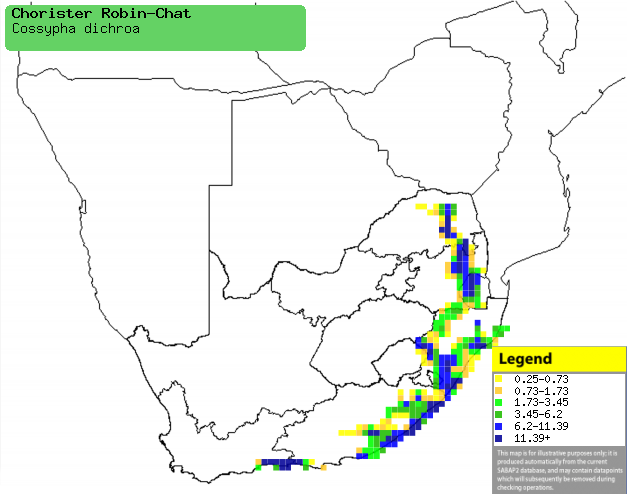|
Cossypha dichroa (Chorister
robin-chat,
Chorister robin)
Lawaaimakerjanfrederik [Afrikaans]; Ugagasisi [Xhosa];
Chorister-lawaaimaker [Dutch]; Cossyphe choriste [French]; Lärmrötel
[German]; Cossifa-de-cabeça-preta [Portuguese]
Life
> Eukaryotes >
Opisthokonta
> Metazoa (animals) >
Bilateria >
Deuterostomia > Chordata >
Craniata > Vertebrata (vertebrates) > Gnathostomata (jawed
vertebrates) > Teleostomi (teleost fish) > Osteichthyes (bony fish) > Class:
Sarcopterygii (lobe-finned
fish) > Stegocephalia (terrestrial
vertebrates) > Tetrapoda
(four-legged vertebrates) > Reptiliomorpha > Amniota >
Reptilia (reptiles) >
Romeriida > Diapsida > Archosauromorpha > Archosauria >
Dinosauria
(dinosaurs) > Saurischia > Theropoda (bipedal predatory dinosaurs) >
Coelurosauria > Maniraptora >Aves
(birds) > Order: Passeriformes
> Family: Muscicapidae > Genus: Cossypha
For information about this species, see
www.birdforum.net/opus/Chorister_Robin_Chat Distribution and habitat
Endemic to southern Africa, occurring from the Limpopo
Province along the eastern escarpment to KwaZulu-Natal, and the lowland forest
of the Eastern Cape, marginally extending into the Western Cape. It generally
prefers Afromontane evergreen forest with high annual rainfall (as well as
adjacent suburban gardens), although in Winter it may move into drier forest
habitats.
|
 |
|
Distribution of Chorister robin-chat in southern Africa,
based on statistical smoothing of the records from first SA Bird Atlas
Project (©
Animal Demography unit, University of
Cape Town; smoothing by Birgit Erni and Francesca Little). Colours range
from dark blue (most common) through to yellow (least common).
See here for the latest distribution
from the SABAP2. |
Brood parasites
It has been recorded as host of the
Red-chested cuckoo.
Food
It mainly invertebrates taken from the ground or gleaned
from vegetation, supplemented with drupes and berries taken from tree and bush
foliage. It often follows antelope, cows and Red driver ant (Dorylus helvolus)
swarms, hawking the insects they disturb. The following food items have been recorded
in its diet:
- Invertebrates
- Fruit
- Asparagus
- Hedychium (ginger lily)
- Celtis (white-stinkwood)
- Rubus (blackberry)
- Scutia myrtina (Cat-thorn)
- Kiggelaria africana (Wild-peach)
- Scolopia (red-pear)
- Cassipourea (onionwood)
- Psidium (guava)
- Lantana camara (Cherry-pie)
- Solanum mauritanium (Bugweed)
- Burchellia bubalina (Wild-pomegranate)
Breeding
- The nest is built solely by the female, consisting of a loose pad of
vegetation with a cup-shaped cavity in its centre, the depth of which varies
from about 2.5-5.0 cm. It can be built of either one or a combination of the
following materials: moss root systems, leaf midribs, lichen, forest grass
and the aerial roots of strangler figs (Ficus). It is typically
placed in a rotten hole or crevice in a tree or hollow stump, anywhere from
1-13 metres above ground.
- Egg-laying season is from about October-November.
- It lays 2-3 eggs, which are incubated solely by the female for about
15-19 days.
- The chicks are regularly brooded by the female for the first few days of
their lives, and are fed by both parents. In one observation they left the
nest after 14 days, and it is though they remain dependent on their parents
for up to 6 weeks more.
Threats
Not threatened.
References
-
Hockey PAR, Dean WRJ and Ryan PG 2005. Roberts
- Birds of southern Africa, VIIth ed. The Trustees of the John Voelcker
Bird Book Fund, Cape Town.
|
